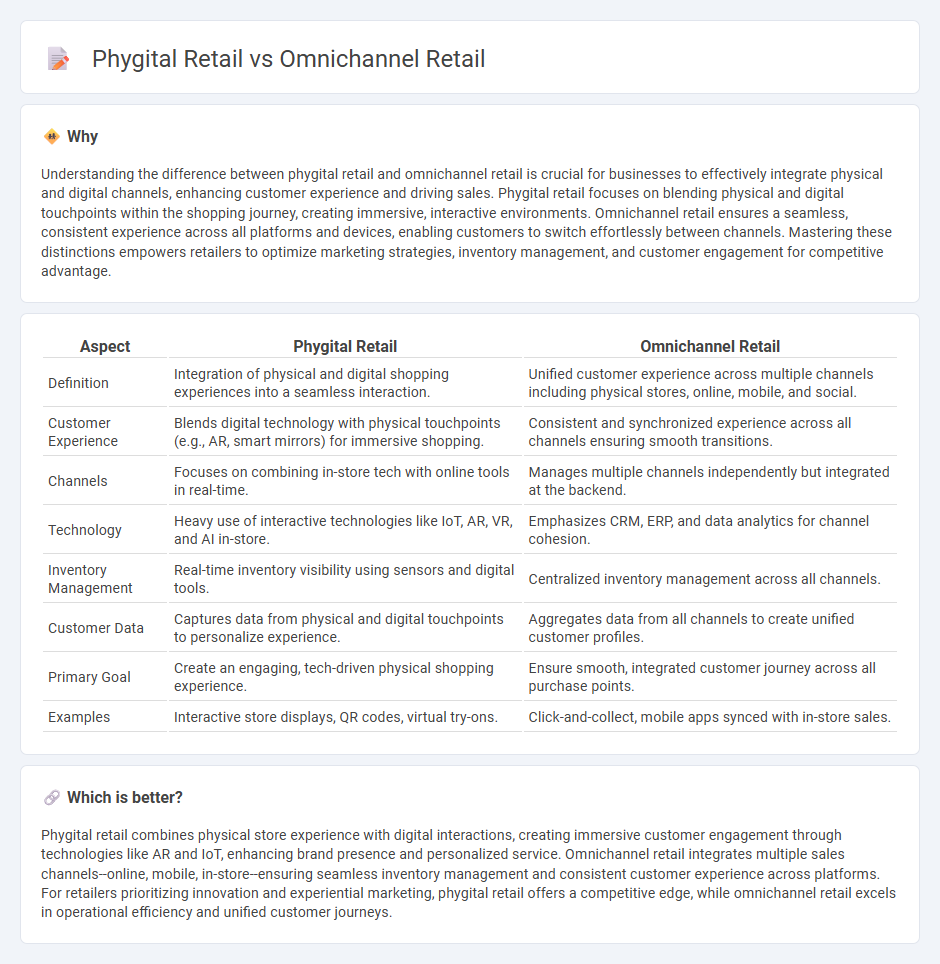
Phygital retail combines physical and digital shopping experiences by integrating in-store technology with online platforms to create seamless customer interactions, enhancing engagement and convenience. Omnichannel retail focuses on providing a unified and consistent customer experience across all channels, including physical stores, e-commerce, mobile apps, and social media, emphasizing channel integration and real-time data synchronization. Explore the advantages and implementation strategies of Phygital and Omnichannel retail to transform your business approach.
Why it is important
Understanding the difference between phygital retail and omnichannel retail is crucial for businesses to effectively integrate physical and digital channels, enhancing customer experience and driving sales. Phygital retail focuses on blending physical and digital touchpoints within the shopping journey, creating immersive, interactive environments. Omnichannel retail ensures a seamless, consistent experience across all platforms and devices, enabling customers to switch effortlessly between channels. Mastering these distinctions empowers retailers to optimize marketing strategies, inventory management, and customer engagement for competitive advantage.
Comparison Table
| Aspect | Phygital Retail | Omnichannel Retail |
|---|---|---|
| Definition | Integration of physical and digital shopping experiences into a seamless interaction. | Unified customer experience across multiple channels including physical stores, online, mobile, and social. |
| Customer Experience | Blends digital technology with physical touchpoints (e.g., AR, smart mirrors) for immersive shopping. | Consistent and synchronized experience across all channels ensuring smooth transitions. |
| Channels | Focuses on combining in-store tech with online tools in real-time. | Manages multiple channels independently but integrated at the backend. |
| Technology | Heavy use of interactive technologies like IoT, AR, VR, and AI in-store. | Emphasizes CRM, ERP, and data analytics for channel cohesion. |
| Inventory Management | Real-time inventory visibility using sensors and digital tools. | Centralized inventory management across all channels. |
| Customer Data | Captures data from physical and digital touchpoints to personalize experience. | Aggregates data from all channels to create unified customer profiles. |
| Primary Goal | Create an engaging, tech-driven physical shopping experience. | Ensure smooth, integrated customer journey across all purchase points. |
| Examples | Interactive store displays, QR codes, virtual try-ons. | Click-and-collect, mobile apps synced with in-store sales. |
Which is better?
Phygital retail combines physical store experience with digital interactions, creating immersive customer engagement through technologies like AR and IoT, enhancing brand presence and personalized service. Omnichannel retail integrates multiple sales channels--online, mobile, in-store--ensuring seamless inventory management and consistent customer experience across platforms. For retailers prioritizing innovation and experiential marketing, phygital retail offers a competitive edge, while omnichannel retail excels in operational efficiency and unified customer journeys.
Connection
Phygital retail integrates physical and digital experiences to create seamless customer interactions, while omnichannel retail ensures consistency across all sales channels, including online, mobile, and in-store. Both strategies prioritize unified customer journeys by leveraging data analytics and real-time inventory management to optimize engagement and satisfaction. This interconnected approach enhances convenience and personalization, driving higher conversion rates and stronger brand loyalty in the retail sector.
Key Terms
Channel Integration
Omnichannel retail seamlessly integrates multiple sales channels, including online, mobile, and brick-and-mortar stores, providing a unified customer experience. Phygital retail blends physical and digital touchpoints within a single environment, enhancing shopper engagement through interactive technologies like AR and smart mirrors. Discover how these strategies optimize channel integration and elevate consumer satisfaction.
Customer Experience
Omnichannel retail integrates multiple channels such as online, mobile, and in-store to provide a seamless customer experience, allowing consumers to interact with brands effortlessly across devices. Phygital retail combines physical and digital elements within the store environment, enhancing customer engagement through technologies like AR, smart mirrors, and interactive kiosks. Explore how leveraging omnichannel and phygital strategies can elevate customer satisfaction and drive loyalty.
Digital-Physical Fusion
Omnichannel retail integrates multiple customer touchpoints such as online stores, mobile apps, and brick-and-mortar locations to deliver a seamless shopping experience across channels. Phygital retail emphasizes the Digital-Physical Fusion by combining immersive technologies like augmented reality and IoT-enabled smart shelves within physical stores to enhance customer engagement and personalization. Explore how these innovative retail strategies transform consumer behavior and optimize operational efficiency.
Source and External Links
What is Omni-Channel Retail? | Salesforce US - Omnichannel retail is a model where shoppers can interact seamlessly across multiple physical and digital sales channels with retained information, allowing them to resume transactions on any channel without restarting.
What is Omnichannel Retailing? Basics Explained - Magestore - Omnichannel retail is a fully integrated business model where all channels, both online and offline, are unified via centralized data management to offer customers a seamless, consistent shopping experience.
What Is Omnichannel Retail? How it Works and Examples (2024) - Omnichannel retail provides a unified customer experience across all touchpoints, blending physical stores, online marketplaces, mobile devices, and social media so customers can buy products anytime, anywhere, on any device.
 dowidth.com
dowidth.com